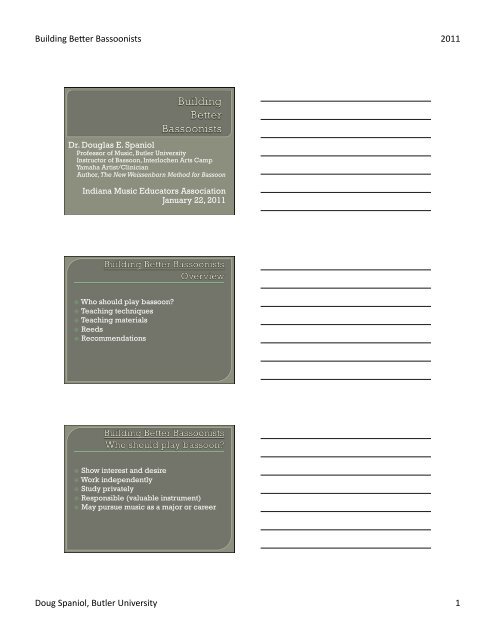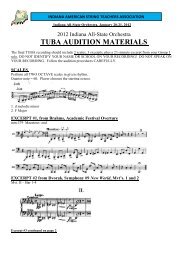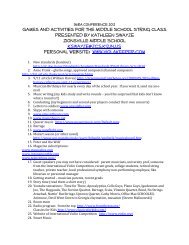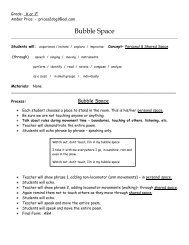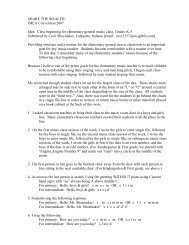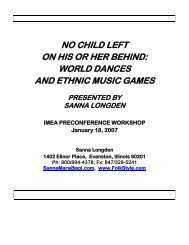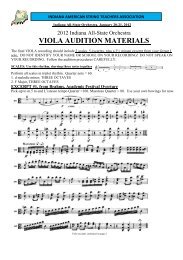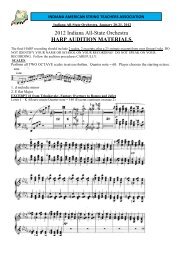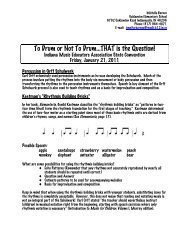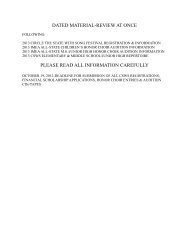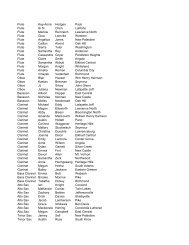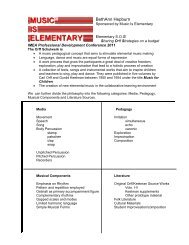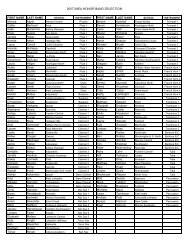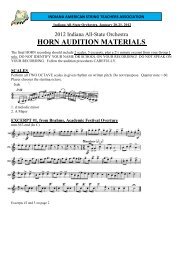Recommended Solos for Bassoon Students - Indiana Music ...
Recommended Solos for Bassoon Students - Indiana Music ...
Recommended Solos for Bassoon Students - Indiana Music ...
You also want an ePaper? Increase the reach of your titles
YUMPU automatically turns print PDFs into web optimized ePapers that Google loves.
Building Be*er <strong>Bassoon</strong>ists 2011<br />
Dr. Douglas E. Spaniol<br />
Professor of <strong>Music</strong>, Butler University<br />
Instructor of <strong>Bassoon</strong>, Interlochen Arts Camp<br />
Yamaha Artist/Clinician<br />
Author, The New Weissenborn Method <strong>for</strong> <strong>Bassoon</strong><br />
<strong>Indiana</strong> <strong>Music</strong> Educators Association<br />
January 22, 2011<br />
� Who should play bassoon?<br />
� Teaching techniques<br />
� Teaching materials<br />
� Reeds<br />
� Recommendations<br />
� Show interest and desire<br />
� Work independently<br />
� Study privately<br />
� Responsible (valuable instrument)<br />
� May pursue music as a major or career<br />
Doug Spaniol, Butler University 1
Building Be*er <strong>Bassoon</strong>ists 2011<br />
Breathing<br />
� Goals<br />
� Amount of air<br />
� Inhale fully<br />
� Torso as one tank<br />
� Fill from bottom<br />
� Expand in all directions<br />
� Exhale as much as the bassoon will take without<br />
<strong>for</strong>cing<br />
� Control of air<br />
� Steady<br />
� Air speed<br />
� Size of air stream<br />
Breathing<br />
� Exercises <strong>for</strong> amount of air<br />
� Inhale with hands on front of belly<br />
� Inhale with hands on sides of belly<br />
� Inhale with hands on lower back<br />
� Inhale with hands on side of rib cage<br />
� Inhale with hands on top of rib cage<br />
� Inhale with one hand on belly, one on top of rib<br />
cage<br />
Breathing<br />
� Exercises <strong>for</strong> control of air<br />
� Timed inhales and exhales<br />
� ||: Inhale 8 beats | Exhale 8 beats :||<br />
� ||: Inhale 6 beats | Exhale 6 beats :||<br />
� ||: Inhale 4 beats | Exhale 4 beats :||<br />
� ||: Inhale 2 beats | Exhale 2 beats :||<br />
� ||: Inhale 1 beat | Exhale 8 beats :||<br />
� ||: Inhale 1 beat | Exhale max # of beats :||<br />
� Play “bocalphone” with no embouchure<br />
� Play bassoon with no embouchure<br />
Doug Spaniol, Butler University 2
Building Be*er <strong>Bassoon</strong>ists 2011<br />
Embouchure<br />
� Goals<br />
� Relaxed, com<strong>for</strong>table, natural<br />
� Slight “oh” or “oo” shape with corners in<br />
� Don’t close blades of reed with lips<br />
� Drawstring analogy<br />
� Lips rolled under slightly<br />
� Lips near center of blade, closer to wire than tip<br />
� Top lip closer to wire than bottom lip (overbite)<br />
Embouchure<br />
� Exercises<br />
� Squeeze reed shut with thumb and index finger<br />
� Open and close reed with embouchure<br />
� Play bocalphone while looking in mirror<br />
� Experiment with more and less reed in mouth<br />
� Experiment with angle of reed entry<br />
� Note: this will be revisited in playing position<br />
Exercises <strong>for</strong> Air and Embouchure<br />
� Bocalphone<br />
� Matching pitches (Middle C)<br />
� Steady long tones<br />
� Extreme waves (oral cavity and throat, not lips)<br />
� Waves followed by steady middle C<br />
� When proper fundamentals are well<br />
established, these same exercises should<br />
be done on bassoon.<br />
Doug Spaniol, Butler University 3
Building Be*er <strong>Bassoon</strong>ists 2011<br />
Articulation<br />
� Goals<br />
� Clean note beginnings<br />
� Air and embouchure set be<strong>for</strong>e starting note<br />
� Remove tongue to start note (valve analogy)<br />
� Light, agile tonguing<br />
� Tip of the tongue, tip of the reed<br />
� Tip of tongue moves up and down (“ta” or “da”)<br />
� Lots of air while tonguing<br />
� Controlled note endings<br />
� With air (“tah” not “tat”)<br />
� Keep pitch steady<br />
� Control of air speed and embouchure/oral cavity/throat<br />
Articulation Exercises<br />
� On bocalphone first, then on bassoon<br />
� “Tonguing on the wind” (legato tonguing)<br />
� “Truck backing up” (good note beginnings)<br />
� Short tones (tapered endings)<br />
� Light, rapid tonguing (“16 th notes on the wind”)<br />
Posture – without instrument<br />
� Learn to play sitting first, standing<br />
(much) later<br />
� Establish good sitting posture<br />
� Good chair<br />
� No arms, not too wide, flat or leaning <strong>for</strong>ward<br />
� Body relaxed<br />
� All joints close to neutral position<br />
� Near chair back (but not leaning on it)<br />
� Sit on back of thighs<br />
� Head away from waist<br />
Doug Spaniol, Butler University 4
Building Be*er <strong>Bassoon</strong>ists 2011<br />
Posture – with instrument<br />
� “Let the bassoon come to you; don’t go to<br />
the bassoon.”<br />
� Place seat strap near front of chair<br />
� Hold bassoon in left hand (centered)<br />
� Bring bassoon reed to mouth<br />
� Adjust height as necessary<br />
� Other adjustments:<br />
� Rotate bocal slightly<br />
� Move right thigh (fulcrum) slightly<br />
� Rotate reed so that it is horizontal<br />
� Shape of bocal effects playing position and<br />
angle of reed entry<br />
� Fox English bend or custom bend bocals<br />
Hand Position<br />
� Goals<br />
� Relaxed, natural<br />
� Close to neutral position<br />
� Fingers gently curved, not collapsed<br />
� Exercises<br />
� Make “O” shape with fingers and thumb and tap<br />
� Change to teardrop and tap<br />
� Individual finger exercises on bassoon<br />
� Quarters, eighths, triplets, sixteenths<br />
Hand Position – Right Thumb<br />
� Goals<br />
� Right thumb over keys, not touching wood. (Put<br />
a piece of tape in that spot to remind students<br />
not to touch there.)<br />
Doug Spaniol, Butler University 5
Building Be*er <strong>Bassoon</strong>ists 2011<br />
Fingerings<br />
� Half-Hole technique<br />
� Left hand 1 (index finger)<br />
� The three G’s (G b 3, G3, G # 3 )<br />
� Roll finger down, do not slide or lift<br />
� “The lower the note, the lower the finger”<br />
Fingering<br />
� ‘ Flicking’ (‘Venting’ or ‘Speaker Keys’)<br />
� Notes: A3, B b 3, B3, C4, (D4)<br />
� Keys: (see next slide also)<br />
� A3 => High A key<br />
� B b 3, B3, C4, => High C key<br />
� D4 => High D key (High C key, or none)<br />
� For beginners: hold down speaker keys just like<br />
‘normal’ octave keys.<br />
Flicking Keys<br />
A3 => High A key B b 3, B3, C4, => High C key<br />
D4 => High D key (High C key, or none)<br />
Doug Spaniol, Butler University 6
Building Be*er <strong>Bassoon</strong>ists 2011<br />
Method Book<br />
� Weissenborn Practical Method<br />
� Originally published in 1887<br />
Weissenborn Practical Method<br />
� Revised by Schaefer in 1920.<br />
� Schaefer deleted:<br />
� 11 pages of introductory text (reeds, fundamentals,<br />
etc.)<br />
� ‘Flicking’ symbols<br />
� 4 pages of text on embellishments<br />
� Chord Studies (<strong>for</strong> intonation)<br />
� Trill Exercises<br />
� Misc instructional annotations<br />
Weissenborn Practical Method<br />
� American editions (Ambrosio 1941, Bettoney 1950)<br />
� Essentially reprints of Schaefer (with deletions)<br />
� Append additional materials<br />
� Not part of Weissenborn’s Method<br />
� How/when to incorporate these is a question<br />
� Too big <strong>for</strong> binding (won’t stay open; get coil binding)<br />
Ambrosio 1941 Bettoney 1950<br />
Doug Spaniol, Butler University 7
Building Be*er <strong>Bassoon</strong>ists 2011<br />
New Weissenborn Method <strong>for</strong> <strong>Bassoon</strong><br />
� Douglas E. Spaniol<br />
� Published by Hal Leonard (2010)<br />
New Weissenborn Method <strong>for</strong> <strong>Bassoon</strong><br />
� Based upon Weissenborn’s original 1887 edition<br />
� For bassoon students and teachers<br />
� Beginning bassoonists through advanced HS<br />
� Assumes students can read music<br />
� If not, see below and handouts <strong>for</strong> suggestions<br />
� OK <strong>for</strong> students who can read music, but not bass clef<br />
� “Air Pocket” binding lays flat on stand<br />
New Weissenborn Method <strong>for</strong> <strong>Bassoon</strong><br />
� Introductory material<br />
� 48 pages with 56 photos<br />
� History of bassoon<br />
� Accessories<br />
� Care of the bassoon<br />
� Assembly/disassembly<br />
� Reeds<br />
� Tone production<br />
� Posture and hand position<br />
� Bibliography<br />
Doug Spaniol, Butler University 8
Building Be*er <strong>Bassoon</strong>ists 2011<br />
New Weissenborn Method <strong>for</strong> <strong>Bassoon</strong><br />
� Introductory material sample - p.45, right hand<br />
New Weissenborn Method <strong>for</strong> <strong>Bassoon</strong><br />
� Practical Exercises<br />
� Begin with<br />
� New terms<br />
� New notes<br />
� Fingerings<br />
� New techniques explained (half-hole)<br />
� Additional exercises where needed<br />
� Exercises numbered<br />
� Not so in other editions<br />
� Measures numbered<br />
� All lessons (but one) contain a duet<br />
� Re-engraved<br />
� Easier to read<br />
� No bad page turns<br />
� Cover all 30 Major and<br />
Minor keys<br />
� Scales given in a consistent <strong>for</strong>mat<br />
New Weissenborn Method <strong>for</strong> <strong>Bassoon</strong><br />
� Supplement<br />
� Organized by range<br />
� Scale studies<br />
� Chord (Intonation) studies<br />
� Trill studies<br />
� Long tones<br />
� Rhythmic exercises<br />
� Requires transposition<br />
� Practical Exercises direct<br />
students to exercises<br />
in supplement based<br />
upon range/notes/keys<br />
Doug Spaniol, Butler University 9
Building Be*er <strong>Bassoon</strong>ists 2011<br />
New Weissenborn Method <strong>for</strong> <strong>Bassoon</strong><br />
� Fingering Chart<br />
� Trill Chart<br />
� Graphic<br />
� With annotations<br />
� Range: B b 1 to B b 4<br />
(same as book)<br />
New Weissenborn Method <strong>for</strong> <strong>Bassoon</strong><br />
� Other features:<br />
� Tenor Clef section expanded<br />
� Ornament section restored and updated<br />
� 17 pages of text, examples, and exercises<br />
� Covers nine ornaments<br />
� Based upon recent research on per<strong>for</strong>mance practice<br />
� Errors corrected<br />
� Indications <strong>for</strong> ‘flicking’ above notes<br />
Materials to supplement NWM<br />
� For students who don’t yet read music<br />
� Standard beginning method book<br />
� Not ‘old’ Weissenborn Method<br />
� Rubank Elementary, Essential Elements, etc.<br />
� OK <strong>for</strong> students who can read music, but not bass clef<br />
� Rhythm<br />
� For beginning students who need additional practice<br />
� To further develop sight-reading and rhythmic skills<br />
� Syncopation<br />
� 20 th (mixed meters, borrowed divisions)<br />
� See handouts<br />
� <strong>Solos</strong><br />
� See handouts<br />
� Advanced etudes and solos (after completing NWM)<br />
� See handouts<br />
Doug Spaniol, Butler University 10
Building Be*er <strong>Bassoon</strong>ists 2011<br />
� Sources<br />
� Private teacher<br />
� Other professional<br />
� Commercial sources<br />
� See handouts<br />
� Care<br />
� Good reed case w/ adequate ventilation<br />
� Cut or drill holes if needed<br />
� Do not store in the container that the reed came in<br />
� Dry when not in use, wet when in use<br />
� Plastic water container in bassoon case, no lid<br />
� Adjustments<br />
� Sealing on bocal?<br />
� Reed and bocal test<br />
� Ream if needed<br />
� Quality reamer (multi-flute, spiral)<br />
� “Iron” reed<br />
� Helps keep reed playing at its best<br />
� Need “iron,” mandrel, plaque<br />
� Tip opening:<br />
More Closed<br />
Less resistant<br />
Less air<br />
Softer dynamic<br />
Sharper pitch<br />
Favors high register<br />
Favors legato<br />
Smaller/brighter<br />
tone<br />
More Open<br />
More resistant<br />
More air<br />
Louder dynamic<br />
Lower pitch<br />
Favors low register<br />
Accents & staccato<br />
Fuller/darker tone<br />
Doug Spaniol, Butler University 11
Building Be*er <strong>Bassoon</strong>ists 2011<br />
� Adjusting tip opening<br />
� To open:<br />
� Squeeze blade wire from sides or<br />
� Squeeze middle wire from top and bottom<br />
� To close:<br />
� Squeeze blade wire from top and bottom or<br />
� Squeeze middle wire from sides<br />
� Blade wire has a more substantial effect<br />
� Middle wire has a more subtle effect<br />
� Middle wire should always be more round (less<br />
flat) than blade wire<br />
� See handouts (or ask me) <strong>for</strong>:<br />
� <strong>Bassoon</strong>s (instruments) <strong>for</strong> schools<br />
� Commercially made reeds<br />
� Teaching materials to supplement New<br />
Weissenborn Method<br />
� Books and other sources<br />
� Questions?<br />
� Feel free to contact me:<br />
Doug Spaniol<br />
Professor of <strong>Music</strong><br />
Butler University<br />
4600 Sunset Ave<br />
<strong>Indiana</strong>polis, IN 46208-3485<br />
317-940-8368<br />
dspaniol@butler.edu<br />
www.butler.edu<br />
Facebook: Doug Spaniol<br />
Doug Spaniol, Butler University 12
Dr. Douglas E. Spaniol<br />
Professor of <strong>Music</strong>, Butler University School of <strong>Music</strong>, <strong>Indiana</strong>polis, <strong>Indiana</strong><br />
Instructor of <strong>Bassoon</strong>, Interlochen Arts Camp, Interlochen, Michigan<br />
Yamaha Artist/Clinician<br />
317-940-8368 800-368-6852, ext 8368 dspaniol@butler.edu www.butler.edu/music<br />
<strong>Recommended</strong> Method Book and Etudes <strong>for</strong> <strong>Bassoon</strong> <strong>Students</strong><br />
Below is a list of much of the material that I use regularly in my teaching, and that I<br />
recommend to students and other teachers. The New Weissenborn Method should be seen as the basic<br />
‘textbook’ <strong>for</strong> beginning bassoon students up to the advanced level. The other materials should be<br />
seen as additional materials to augment The New Weissenborn Method or to work on after it has been<br />
completed. Whatever the case, it is strongly recommended that whenever practical students coordinate<br />
the keys of their scale and chord studies with the key of their etudes, i.e when practicing a C Major<br />
scale/chord study also practice C Major etudes.<br />
Method Book<br />
• Spaniol, Douglas E., and Julius Weissenborn. The New Weissenborn Method <strong>for</strong> <strong>Bassoon</strong>.<br />
Milwaukee, WI: Hal Leonard, 2010.<br />
This is the new standard method book <strong>for</strong> bassoonists, replacing the previous editions of<br />
the Weissenborn Method. Based upon Weissenborn’s original 1887 edition, it restores much of the<br />
material and pedagogical intent that had been deleted from other editions and updates Weissenborn’s<br />
work to make a much more user-friendly method book. It begins with 48 pages of in<strong>for</strong>mation that all<br />
bassoon students need to know, including 56 photos. The lessons are easier to read with no bad page<br />
turns, and all lessons (but one) have a duet. At the top of each lesson you will find the new notes,<br />
fingerings, techniques, and terms introduced in that lesson. Each exercise is numbered and flicking<br />
symbols are found above each note that should be flicked. (Weissenborn’s original has these two<br />
features, but <strong>for</strong> some reason later editors deleted them!) The sections on tenor clef and ornaments<br />
have been expanded. The supplement of daily scale and chord exercises has also been expanded by<br />
replacing previously deleted exercises and including new ones. Covers all 30 major and minor keys<br />
and includes new fingering chart and trill chart.<br />
N.B. All editions of the Weissenborn Method (including The New Weissenborn Method <strong>for</strong> <strong>Bassoon</strong>)<br />
are designed <strong>for</strong> students who can already read music. (It’s OK if they can’t read bass clef.) For<br />
students who can’t read music, begin with the Rubank Elementary Method or a standard band method<br />
(i.e. Essential Elements) and then move to The New Weissenborn Method.<br />
Rhythmic Etudes<br />
• Yaus, Grover C. 101 Rhythmic Rest Patterns. Miami: Warner Bros (Belwin Mills).<br />
For younger students who need additional help with rhythmic skills. May begin once students<br />
have begun Lesson XI in The New Weissenborn Method. Make sure that you get the “Baritone<br />
B.C./<strong>Bassoon</strong>” edition. (The Yaus book is available <strong>for</strong> all band instruments.)
Rhythmic Etudes (continued)<br />
• Bona, Pasquale. Rhythmical Articulation. NY, NY: Carl Fischer.<br />
Originally the second part of a sight-singing text, these have been adapted <strong>for</strong> instrumental<br />
study. Progressively more difficult, these 41 etudes pose myriad rhythmic challenges. May begin once<br />
students have begun Lesson XX in The New Weissenborn Method. Be sure to get the bass clef<br />
version!<br />
• Dufresne, Gaston. Develop Sight Reading. NY, NY: Charles Colin <strong>Music</strong>.<br />
Overlaps with Bona in degree of difficulty, but the later etudes pose new challenges, especially<br />
regarding unusual and mixed meters. Begin after Bona is completed.<br />
Scale and Chord Etudes<br />
NOTE: The “Supplement” to The New Weissenborn Method provides plenty of scale and chord<br />
exercises <strong>for</strong> beginning and intermediate bassoon students. It is also designed to improve their rhythm<br />
and their skills in transposing, music theory, and intonation. Each time a scale is introduced in the<br />
lessons, the student is directed to the appropriate exercise in the “Supplement”. For advanced students<br />
who have completed The New Weissenborn Method, I recommend the following:<br />
• Weait, Christopher. <strong>Bassoon</strong> Scales <strong>for</strong> Reading. Worthington, OH: Christopher Weait.<br />
Broken down into low, middle, and higher ranges. Covers virtually all scales and arpeggios<br />
that one would ever want to practice. Available at .<br />
• Milde, Ludwig. Twenty Five Studies in Scales and Chords, op. 24. NY, NY: International.<br />
One scale and one arpeggio etude <strong>for</strong> each of twelve key signatures plus one chromatic<br />
exercise.<br />
• Giampieri, Alamiro. Sixteen Daily Studies. Milan: Ricordi.<br />
Each etude takes a pattern/motive through all keys. Good review <strong>for</strong> bassoonists who have<br />
learned their chords and scales well and are looking <strong>for</strong> maintenance work.<br />
Advanced Etudes<br />
• Weissenborn, Julius, ed. by William Waterhouse. Studies, op. 8, no. 2 (<strong>for</strong> Advanced Pupils).<br />
Vienna: Universal Edition (UE 18 122)<br />
For use after students have completed The New Weissenborn Method, these advanced<br />
etudes cover almost every key through seven flats and seven sharps and the entire range of the<br />
instrument. The above edition restores Weissenborn’s original order and keys and makes a much more<br />
user-friendly book. However, it may be hard to find. If need be, you can usually find the more<br />
common but less useful edition (published by International Editions).<br />
• Milde, Ludwig. Concert Studies, Op. 26. NY, NY: International.<br />
These Romantic etudes are a cornerstone of bassoon study <strong>for</strong> advanced students. They pose<br />
plenty of technical challenges, but more importantly pose musical challenges to overcome. Usually<br />
sold in two volumes. Not all keys are covered; there is no order to the key structure. Begin after the<br />
Weissenborn op. 8, no. 2 advanced studies are completed.
Dr. Douglas E. Spaniol<br />
Professor of <strong>Music</strong>, Butler University School of <strong>Music</strong>, <strong>Indiana</strong>polis, <strong>Indiana</strong><br />
Instructor of <strong>Bassoon</strong>, Interlochen Arts Camp, Interlochen, Michigan<br />
Yamaha Artist/Clinician<br />
317-940-8368 800-368-6852, ext 8368 dspaniol@butler.edu www.butler.edu/music<br />
<strong>Recommended</strong> <strong>Solos</strong> <strong>for</strong> <strong>Bassoon</strong> <strong>Students</strong><br />
Below is a list of bassoon solos <strong>for</strong> beginning through advanced bassoon students. Especially<br />
<strong>for</strong> younger students there is a strong emphasis on collections of solos (as opposed to solos published<br />
individually). There are several reasons <strong>for</strong> this: 1) collections tend to be ordered with some<br />
pedagogical rationale, 2) they are convenient and avoid losing time while waiting <strong>for</strong> the student to get<br />
their next solo, and 3) they are more cost effective.<br />
Of course, it’s not expected that students would play all of these solos. In fact, choosing solo<br />
repertoire is a great opportunity to individualize instructional material.<br />
<strong>Solos</strong> are categorized as beginner, intermediate, and advanced. Each entry contains publication<br />
in<strong>for</strong>mation, as well as in<strong>for</strong>mation about range, style/era/genre of the composition, and whether or not<br />
it includes tenor clef. <strong>Solos</strong> in the beginner and intermediate categories are also referenced to The<br />
New Weissenborn Method. <strong>Solos</strong> in the advanced category should not be assigned until students have<br />
completed The New Weissenborn Method.<br />
Beginner<br />
• Hilling, Lyndon, and Walter Bergmann. First book of bassoon solos. London: Faber <strong>Music</strong>, 1979.<br />
Range: first solo = C3–F3; entire collection = D2–D4<br />
Style/Era/Genre: 28 short solos from baroque, classical, romantic eras, plus folk tunes and a<br />
few original compositions. Contains in<strong>for</strong>mation and/or per<strong>for</strong>mance suggestions <strong>for</strong> each solo.<br />
Tenor Clef: no The New Weissenborn Method: Lesson IV – Lesson XVIII.a<br />
• Sheen, Graham. The really easy bassoon book. London: Faber <strong>Music</strong>, 1988.<br />
Range: first solo = C3–F3; entire collection = F2–D4<br />
Style/Era/Genre: 13 short solos, 6 composed by Graham Sheen, 7 well known melodies from<br />
renaissance through romantic.<br />
Tenor Clef: no The New Weissenborn Method: Lesson IV – Lesson XVIII.a<br />
Intermediate<br />
• Galliard, John Ernest. Six Sonatas, vols. I and II. NY, NY: International <strong>Music</strong> Co, 1949.<br />
Range: C2 – G4 (F4 in some sonatas)<br />
Style/Era/Genre: 6 baroque sonatas (more like suites, really), each with 3-5 short movements.<br />
Difficulty varies, intermediate to advanced (esp. depending on tempi and ornamentation).<br />
Tenor Clef: yes, in some sonatas/movements<br />
The New Weissenborn Method: Lesson XX (up to F4) – Lesson XXVI (esp. <strong>for</strong> ornamentation)<br />
• Hilling, Lyndon, and Walter Bergmann. Second book of bassoon solos. London: Faber <strong>Music</strong>, 1981.<br />
Range: easiest solo = D#3–E4; entire collection = C2-A4<br />
Style/Era/Genre: 16 solos, mostly baroque and classical<br />
Tenor Clef: yes The New Weissenborn Method: Lesson XX – Lesson XXVI (end)
• Sharrow, Leonard. Master solos, intermediate level. Milwaukee, WI: Hal Leonard, 1975.<br />
Range: first solo = E2–C4; entire collection = C2–B b 4<br />
Style/Era/Genre: 8 solos, baroque through 20 th Century. Contains extensive per<strong>for</strong>mance<br />
in<strong>for</strong>mation and suggestion (2-3 pages per solo) and includes a CD of all solos, with solo and<br />
accompaniment only <strong>for</strong> students to practice with.<br />
Tenor Clef: yes The New Weissenborn Method: Lesson XV – Lesson XXVI (end)<br />
• Sheen, Graham. Going solo. London: Faber <strong>Music</strong>, 1993.<br />
Range: first solo = C3–D4; entire collection = G2–B b 4<br />
Style/Era/Genre: 12 solos, from renaissance through 20 th Century (Bartok, Satie)<br />
Tenor Clef: no (!) The New Weissenborn Method: Lesson XVIII.a – Lesson XXVI (end)<br />
• Waterhouse, William. <strong>Bassoon</strong> solos, vol. I. London: Chester <strong>Music</strong>, 1977.<br />
Range: first solo = G2–F4; entire collection = B b 1–G4<br />
Style/Era/Genre: 9 solos, from baroque through 20 th Century. Comes with background<br />
in<strong>for</strong>mation about each piece and some per<strong>for</strong>mance suggestions. Note that all pieces were originally<br />
composed <strong>for</strong> bassoon.<br />
Tenor Clef: no (!) The New Weissenborn Method: Lesson XX – Lesson XXI.a<br />
Advanced<br />
• Waterhouse, William. <strong>Bassoon</strong> solos, vol. II. London: Chester <strong>Music</strong>, 1977.<br />
Range: first solo = D2–C4; entire collection = B b 1-C # 5<br />
Style/Era/Genre: 8 solos, from baroque through 20 th Century. Comes with background<br />
in<strong>for</strong>mation about each piece and some per<strong>for</strong>mance suggestions. Contains many advanced rhythmical<br />
and technical challenges. Note that all pieces were originally composed <strong>for</strong> bassoon.<br />
Tenor Clef: yes<br />
Individual <strong>Solos</strong> (Advanced)<br />
• Hindemith, Paul. Sonate für fagott und piano. Mainz: B. Schott's Söhne, 1967.<br />
Range: D3 – B b 4 Style/Era/Genre: 20 th Century Tenor Clef: yes (lots)<br />
• Mozart, Wolfgang Amadeus. Concerto in B-flat major KV 191 (186e). Kassel: Bärenreiter, 2003.<br />
Range: B b 2 – B b 4 Style/Era/Genre: Classical Tenor Clef: yes<br />
NOTE: Please use this edition! It includes cadenzas, lead-ins, and in<strong>for</strong>mation about historical<br />
per<strong>for</strong>mance practice as it relates to this concerto. Armed with this material and the in<strong>for</strong>mation on<br />
ornamentation provided in The New Weissenborn Method, an advanced student can come to an<br />
intelligent, historically in<strong>for</strong>med per<strong>for</strong>mance of this work – the most important work in the bsn rep!<br />
• Mozart, Wolfgang Amadeus.) Sonata in B-flat major, KV 292 (196c). Kassel: Bärenreiter, 1990.<br />
Range: F3 – B b 4 Style/Era/Genre: Classical Tenor Clef: yes<br />
NOTE: Please use this edition! May be played as a duet (w/ bsn or vcl) or with piano.<br />
• Phillips, Burrill. Concert piece. N.Y.: Carl Fischer, 1940.<br />
Range: B b 1 – A4 Style/Era/Genre: 20 th Century (jazzy, ala Gershwin) Tenor Clef: yes<br />
• Pierné, Gabriel, and Himie Voxman. Solo de concert. Chicago: Rubank, 1941.<br />
Range: C2 – D5 Style/Era/Genre: Romantic Tenor Clef: no (!)
Dr. Douglas E. Spaniol<br />
Professor of <strong>Music</strong>, Butler University School of <strong>Music</strong>, <strong>Indiana</strong>polis, <strong>Indiana</strong><br />
Instructor of <strong>Bassoon</strong>, Interlochen Arts Camp, Interlochen, Michigan<br />
Yamaha Artist/Clinician<br />
317-940-8368 800-368-6852, ext 8368 dspaniol@butler.edu www.butler.edu/music<br />
<strong>Recommended</strong> Books, Sources of In<strong>for</strong>mation,<br />
and Sources <strong>for</strong> Reeds <strong>for</strong> <strong>Bassoon</strong> <strong>Students</strong><br />
Books on Per<strong>for</strong>mance<br />
• Waterhouse, William. The <strong>Bassoon</strong>. London: Kahn & Averill, 2004.<br />
“Eminent bassoonist William Waterhouse presents a personal view of how to play the<br />
instrument…giving detailed and authoritative guidance on the mastery of this rewarding instrument.<br />
This practical manual, copiously illustrated with diagrams and music examples, offers beginner and<br />
expert alike a thorough and systematic treatment of every aspect of per<strong>for</strong>mance…. There is also<br />
guidance on choice of instrument and reeds as well as advice on maintenance, how to practise, how to<br />
teach, and how to cope with the challenges of audition and competition. There are hints on the<br />
per<strong>for</strong>mance of concertos my Mozart and Weber, a list of recommended solo repertoire and an<br />
extensive bibliography.” 272 pp, paperback.<br />
• Weait, Christopher. <strong>Bassoon</strong> Strategies <strong>for</strong> the Next Level. Worthington, OH: Christopher Weait,<br />
2003.<br />
Compilation of materials and advice from one of the great per<strong>for</strong>mers and teachers of our time.<br />
In 17 chapters covering virtually all aspects of learning, teaching, and per<strong>for</strong>ming on the bassoon.<br />
Also includes very useful annotated bibliographies. 185 pp., paperback.<br />
• Weisberg, Arthur. The Art of Wind Playing. Plainview, NY: Accurate Double Reed, 1993.<br />
Written by a bassoonist this book is very useful in thinking about the fundamentals of playing<br />
the bassoon and how to improve them. 145 pages, hardcover.<br />
General <strong>Music</strong> Reference<br />
• Randel, Don Michael, ed. The Harvard Dictionary of <strong>Music</strong>. Cambridge, Mass: Harvard University<br />
Press, 2003.<br />
One volume, authoritative dictionary on all things musical.<br />
• Sadie, Stanley and J. Tyrell, eds. The New Grove Dictionary of <strong>Music</strong> and <strong>Music</strong>ians. London:<br />
Macmillan, 2001.<br />
A 22 volume set. Rightfully called “The world’s premier authority on all aspects of music”.<br />
Other Sources of In<strong>for</strong>mation<br />
• International Double Reed Society (IDRS)<br />
Hosts valuable and useful website at www.idrs.org. Members receive quarterly publication,<br />
The Double Reed and may subscribe to the e-mail listserv IDRS-L. Both of these offer a wealth of<br />
in<strong>for</strong>mation to and from members. The IDRS also hosts an annual conference. The location changes<br />
every year; the conference is usually in the summer and lasts ca. 5 days. All interested bassoonists and<br />
oboists would benefit from becoming members of IDRS; membership in<strong>for</strong>mation is available online<br />
at idrs.org.
• <strong>Music</strong>alchairs.info<br />
Good source <strong>for</strong> used instruments, auditions, competitions, workshops, youth orchestras, etc.<br />
• <strong>Bassoon</strong>.org<br />
A good starting point if looking <strong>for</strong> links to retailers, bassoon teachers, etc.<br />
Books on Reed-Making<br />
• Eubanks, Mark. Advanced Reed Design & Testing Procedure <strong>for</strong> <strong>Bassoon</strong>. Portland, OR: Arundo<br />
Research Co., 1993.<br />
A logical and systematic approach to finishing bassoon reeds that has been adopted by many<br />
bassoonists.<br />
• McKay, James, et al. The <strong>Bassoon</strong> Reed Manual: Lou Skinner’s Theories and Techniques.<br />
<strong>Indiana</strong>polis: <strong>Indiana</strong> University Press, 2000.<br />
Detailed description of a master reedmaker’s approach and techniques.<br />
• Popkin, Mark and Loren Glickman. <strong>Bassoon</strong> Reed Making. Northfield, IL: The Instrumentalist Co.,<br />
1987.<br />
A standard text <strong>for</strong> reed-making; also discusses instrument repair and per<strong>for</strong>mance physiology.<br />
• Weait, Christopher. <strong>Bassoon</strong> Reed-Making: An Illustrated Basic Method. Worthington, OH:<br />
Christopher Weait, 2008<br />
The best guide available <strong>for</strong> step-by-step instructions on building and finishing a reed. Over<br />
150 photographs. Also see DVD Making a <strong>Bassoon</strong> Reed. Find both at .<br />
Sources <strong>for</strong> Reeds<br />
• Private Teacher<br />
Your private teacher should be able to supply you with quality reeds. S/he may do this buy<br />
making reeds from scratch, buying commercial reeds and adjusting them as needed, or by directing<br />
you to a reliable source of appropriate reeds. This is one of the many reasons why it’s important <strong>for</strong><br />
bassoonists to have a well-qualified private teacher! Your teacher should also be able to adjust your<br />
reeds as needed during lessons and teach you to adjust and make reeds when the time comes.<br />
• Hand-Made Reeds<br />
You may be able to find very good reeds from a professional bassoonist/reedmaker even if s/he<br />
is not your private teacher. Check with the local chapter of your musician’s union (AFM American<br />
Federation of <strong>Music</strong>ians) or advertisements in IDRS publications or on bassoon.org.<br />
• Commercially Manufactured Reeds<br />
Not too long ago decent commercial reeds were little more than a myth. Nowadays there are a<br />
few good options on the market if you need to resort to this option. I suggest the following reeds in<br />
this order, although it’s best to try them all and see which works best <strong>for</strong> you and your bassoon. All of<br />
these reeds are available from Miller Marketing, www.millermarketingco.com or 800-323-3216.<br />
Miller Select Reserve, standard (blue) reed (try the others too!)<br />
Danzi, standard or professional, regular (not wide) shape.<br />
Neuranter
Dr. Douglas E. Spaniol<br />
Professor of <strong>Music</strong>, Butler University School of <strong>Music</strong>, <strong>Indiana</strong>polis, <strong>Indiana</strong><br />
Instructor of <strong>Bassoon</strong>, Interlochen Arts Camp, Interlochen, Michigan<br />
Yamaha Artist/Clinician<br />
317-940-8368 800-368-6852, ext 8368 dspaniol@butler.edu www.butler.edu/music<br />
Below are bassoons that I recommend most often <strong>for</strong> various ‘generic’ situations. Nowadays,<br />
there are many fine bassoons on the market; these are by no means the only bassoons worth<br />
considering. Note that <strong>for</strong> all school situations, I recommend a polypropylene bassoon. The<br />
advantage of these bassoons is that they are much more durable than wood. This benefit far<br />
outweighs any/all of the possible minor disadvantages. (If you want to have a bassoon that<br />
‘sounds like wood’ enquire about a wooden bell.) For all Fox and Fox Renard bassoons, I<br />
recommend that the bocals be a #2 and #3 in length. I also recommend they be upgraded to<br />
“double star” bocals, i.e. “*CVX*”. If a bassoon does not come with a B-flat key guard, a body<br />
lock, or a whisper key lock, I recommend that these be added. I prefer the left hand whisper key<br />
lock, but the right hand one is adequate.<br />
For Elementary Schools: The Fox Renard Model 51, aka “the short reach bassoon’. <strong>Bassoon</strong>s are<br />
rather large instruments, and younger/smaller people often have difficulties reaching keys and<br />
covering tone holes. These instruments help to alleviate this problem. For an elementary school<br />
inventory, I recommend that at least half of the bassoons be Model 51’s; you might also want to<br />
have some Model 41’s in the inventory (virtually identical model but without the ‘short reach’<br />
modifications) <strong>for</strong> students with larger hands/stature.<br />
For Middle Schools: Same as above, but you’ll probably need more 41’s and fewer 51’s.<br />
For High Schools: I would recommend that you have at least one Model 51. For the other<br />
bassoons, I recommend the Fox Model IV. This is a fully professional model, nearly identical to<br />
the Model II, but made of polypropylene. If you have the room in your budget, you may want to<br />
upgrade to a Model III, which is slightly nicer/more expensive than the Model IV, although some<br />
of the differences are cosmetic.<br />
For <strong>Students</strong>’ Own <strong>Bassoon</strong>: Buying a bassoon is a big investment. Be<strong>for</strong>e purchasing a<br />
bassoon, make sure that the student is mature enough to take very good care of it and committed<br />
enough to warrant the investment. (If well cared <strong>for</strong>, quality bassoons will hold their value well.)<br />
For such students, I usually recommend the Fox Renard 240. This is a fine (wooden) instrument<br />
and most bassoonists will be very happy with it into their college years and possibly beyond.<br />
Purchasing a ‘professional’ level instrument is usually based more on personal taste, and one<br />
should try several different brands/models be<strong>for</strong>e settling on a bassoon. Several years ago, I<br />
switched from a fine Heckel bassoon to a Yamaha YFG-811. I’m very happy with my Yamaha<br />
bassoon; it has all the flexibility of my Heckel but with much greater ease of playing. I would<br />
recommend that anyone interested in purchasing a professional level bassoon include Yamaha in<br />
the bassoons they try out.


